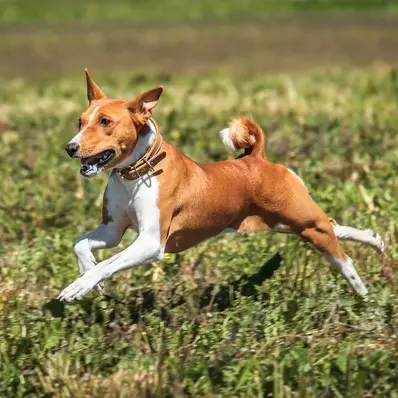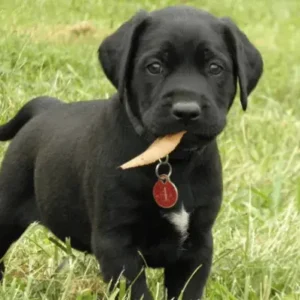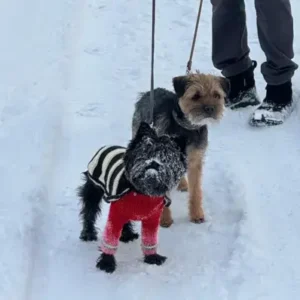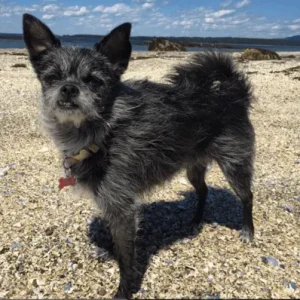Basenji History/Origin
The Basenji breed has its origins in Africa, particularly the Congo region, and dates back to ancient times.
However, it wasn’t until 1895 that Europeans first encountered and described this remarkable breed. Local tribes valued Basenjis highly for their exceptional intelligence, courage, impressive speed, and, notably, their unique silence.
Early attempts to introduce Basenjis to England faced significant challenges due to disease outbreaks. However, despite these setbacks, successful imports to both England and the United States occurred in the 1930s, garnering attention and admiration for the breed.
In 1943, the American Kennel Club (AKC) officially recognized the Basenji breed under Hound Group, solidifying its place in the world of purebred dogs. Over the years, the breed’s popularity has fluctuated, with periods of heightened interest followed by declines.
Interestingly, Basenji’s story continued to unfold with the reopening of its stud book in 1990 and again from 2009 to 2013 in the Basenji Club of America.
Mirrie Cardew and her Basenji- Source: AKC.org
In 2010, an American-led expedition ventured to the Democratic Republic of Congo to collect breeding stock. Today, the Basenji is recognized by both the AKC and the United Kennel Club (UKC).
Despite its enduring legacy, the Basenji’s popularity in the United States has experienced fluctuations, with its ranking declining from 71st in 1999 to 93rd in 2011, according to data from the American Kennel Club. Nonetheless, Basenji enthusiasts continue to cherish and celebrate this unique and ancient breed for its distinctive traits and fascinating history.
Basenji’s likeness to Ancient Egyptian limestone statues (1080-332 BC)- Source: AKC.org
Basenji Personality
Basenjis are intelligent, independent, and sometimes mischievous. They are known for their cat-like grooming habits and unique yodel-like vocalizations.
As highly active dogs, they thrive on constant mental and physical stimulation. Their curiosity and fascination with movement may lead them to chase after other pets or even small creatures.
Despite their independent nature, they are deeply loyal and protective of their owners, making them excellent watchdogs.
When it comes to training, Basenjis’ intelligence shines through, but their stubborn streak can present challenges. Patience and consistency are key when teaching them commands and behaviors.
- Basenji Temperament
Basenjis possess a dynamic and spirited temperament. They are highly active dogs that thrive on mental and physical challenges.
They are known for their alertness and may be quick to react to perceived threats. However, their protective instincts can sometimes translate into aggression towards strangers if not properly socialized.
Despite their independent streak, Basenjis form strong bonds with their families and enjoy spending time with them. They require regular exercise and mental stimulation to keep them happy and content.
Basenji Physical Appearance
Basenjis have a sleek, athletic body. They have well-defined heads with distinctive foreheads and smart, curious eyes. Their small, upright ears add to their alert look.
They have deep chests and straight backs, with tails that curl gracefully over their backs. Their strong hind legs help them move swiftly and gracefully.
- Basenji Size
They are medium-sized dogs with a sleek, muscular build. They typically stand between 16 to 17 inches at the shoulder and weigh around 22 to 24 pounds on average. Their balanced proportions give them an elegant and athletic appearance.
- Coat Color
Basenjis have short, fine coats that come in various colors and combinations. Common coat colors include red, black, brindle, and tricolor patterns. Some may also have white markings on their chest, feet, and tail tips.
The breed’s coat is smooth and glossy, requiring minimal grooming to maintain its sleek appearance. They shed lightly throughout the year, making them relatively low-maintenance in terms of grooming.
Basenji Gender Differences
Male Basenjis may be slightly larger and more dominant, while females tend to be more reserved.
Basenji Feed/Nutrition
Basenjis need a well-rounded diet tailored to their age, size, and activity level. Opt for high-quality dog food with real meat as the main ingredient, along with essential nutrients. Avoid foods with artificial additives and fillers.
You can supplement their diet with fresh fruits like orange and vegetables like carrot as healthy treats. Additionally, peanuts can be given in moderation as a nutritious snack. Ensure they have access to clean, fresh water at all times.
Monitor their weight and adjust food intake as needed to prevent obesity. Regular vet check-ups can guide their dietary needs.
Basenji Health Issues
Basenjis are generally a healthy dog breed, but they may be prone to certain conditions such as hip dysplasia and others like:
- Fanconi Syndrome: Fanconi syndrome is a rare genetic disorder affecting the kidneys’ ability to reabsorb certain nutrients, electrolytes, and fluids into the bloodstream. This leads to the excessive excretion of glucose, electrolytes, and other substances in the urine, resulting in dehydration, weakness, and other symptoms. Preventive measures include genetic testing of breeding stock to identify carriers and avoid breeding-affected dogs.
- Progressive Retinal Atrophy (PRA): Progressive retinal atrophy is an inherited eye disorder that causes gradual degeneration of the retina, leading to progressive vision loss and eventual blindness. Symptoms typically start with difficulty seeing in low light and peripheral vision loss, eventually progressing to complete blindness. Unfortunately, there is no cure for PRA, but early detection through regular eye screenings can help manage the condition and delay vision loss. Genetic testing is available to identify carriers and inform breeding decisions, reducing the risk of passing on the disease.
- Immunoproliferative Systemic Intestinal Disease: Immunoproliferative systemic intestinal disease, also known as Basenji enteropathy, is a condition characterized by chronic inflammation of the gastrointestinal tract. Symptoms may include diarrhea, vomiting, weight loss, and poor appetite. Treatment typically involves dietary modifications, medications to control inflammation and manage symptoms, and supportive care to maintain hydration and nutrition. Regular monitoring and veterinary follow-up are essential to monitor disease progression and adjust treatment as needed.
- Pyruvate Kinase Deficiency (Hemolytic Anemia): Pyruvate kinase deficiency is an inherited disorder that affects red blood cells’ ability to produce energy, leading to hemolytic anemia. Affected dogs experience the premature destruction of red blood cells, resulting in symptoms such as lethargy, pale gums, jaundice, and an enlarged spleen. Genetic testing is available to identify carriers and inform breeding decisions, reducing the risk of passing on the disease to offspring.
Basenji Care and Grooming
Basenjis are low-maintenance in terms of grooming due to their short coats. They possess a cat-like self-grooming habit, often licking themselves clean.
Their fine, short coat results in minimal shedding, which is not very noticeable. However, during shedding seasons, occasional brushing can help remove loose hair.
While Basenjis generally stay clean, they may require a bath when they get dirty or to remove any accumulated dirt or odors.
Regular nail trimming and daily toothbrushing are essential to maintain their overall health and hygiene. Keeping their nails trimmed helps prevent overgrowth and potential issues, while teeth brushing help prevent dental problems. Additionally, crate training your dog can provide a safe, comfortable space and assist with house training.
Basenji Rescue Groups
There are several Basenji rescue groups dedicated to finding loving homes for Basenjis in need.
Basenji Price
The price of a Basenji typically ranges from $800 to $1,500, depending on the breeder and the dog’s lineage.
When purchasing a Basenji puppy, it’s crucial to choose a reputable Basenji breeder who prioritizes the health and welfare of the dogs.
Interesting Facts
- Basenjis are known as the “barkless dogs” because they produce a unique sound known as a “barroo” or “yodel.” They have a differently shaped larynx that causes them to only produce a light growl. This is why African tribes would tie bells around their necks when taking them for hunting.
- Basenjis are proficient self-groomers, exhibiting cat-like grooming behaviors. They groom themselves to maintain their cleanliness and hygiene, often licking their coats to remove dirt and debris.
- They have been featured in “Goodbye, My Lady”.
Goodbye, My Lady- Source: AKC.org
Best For
Basenjis make good family dogs for active families who appreciate their energetic nature, independence, and unique vocalizations.
Top Names
| Male Basenji Names | Female Basenji Names |
| Loki | Daisy |
| Duke | Stella |
| Simba | Rosie |
| Milo | Sadie |
| Apollo | Chloe |









 Mirrie Cardew and her Basenji- Source:
Mirrie Cardew and her Basenji- Source:  Basenji’s likeness to Ancient Egyptian limestone statues (1080-332 BC)- Source:
Basenji’s likeness to Ancient Egyptian limestone statues (1080-332 BC)- Source: 

 Tricolor Basenji- Source:
Tricolor Basenji- Source:  Red Basenji- Source:
Red Basenji- Source:  Black and white Basenji- Source:
Black and white Basenji- Source:  Brindle Basenji- Source:
Brindle Basenji- Source: 
 Goodbye, My Lady- Source:
Goodbye, My Lady- Source: 






